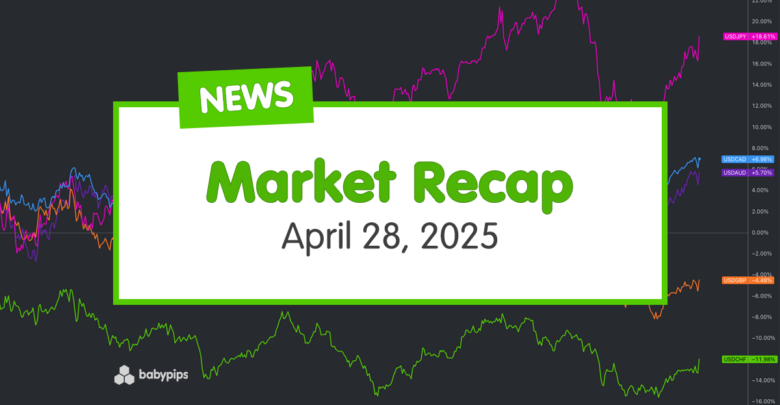This week was off to a relatively quiet start in terms of economic data and global headlines, yet the U.S. dollar still staged a broad selloff later in the day.
Here are the latest headlines driving price action in the past trading sessions:
Headlines:
- China Industrial Profits for March 2025: 0.8% ytd/y (0.1% forecast; -0.3% previous)
- Chinese Foreign Ministry clarified that Trump and President Xi did not have a call recently
- Japanese Economy Minister reiterated that they are still demanding the removal of U.S. tariffs
- France Unemployment Benefit Claims for March 2025: -28.5k (15.0k forecast; 67.0k previous)
- U.K. CBI Distributive Trades for April 2025: -8.0 (-32.0 forecast; -41.0 previous)
- Canada Wholesale Sales for March 2025: -0.3% m/m (0.6% m/m forecast; 0.3% m/m previous)
- ECB official Villeroy reiterated that they have a margin for rate cuts in the region but does not see extra inflation or even a potential recession
- ECB official Guindos pointed out that incoming data reflected modest growth early this year
- ECB official Rehn: More rate cuts possible if inflation outlook falls below 2% target
- U.S. Treasury Secretary Bessent noted that China’s tariffs exemptions suggest they also want a de-escalation of trade war
- U.S. Dallas Fed Manufacturing Index for April 2025: -35.8 (-15.0 forecast; -16.3 previous)
- White House spokesperson said that U.S. trade talks with the U.K. are going in the right direction
- U.S. Treasury Refunding Financing Estimates projected $512B in borrowing for Q2, up from earlier $123B estimate
- Canadian parliamentary elections concluded with early polls pointing to victory for PM Carney and Liberal party
Broad Market Price Action:

Dollar Index, Gold, S&P 500, Oil, U.S. 10-yr Yield, Bitcoin Overlay Chart by TradingView
There wasn’t much on the docket in terms of top-tier data points or even major trade headlines, leaving most asset classes struggling to find a clear direction for the most part of the day. It didn’t help that most European markets were out for Easter Monday while Japanese banks were also closed, leading to tighter liquidity conditions.
Risk assets like commodities and crypto appeared to shrug off the China’s clarification that Presidents Trump and Xi have not had any communication at all, although U.S. officials continue to assure that trade deals with partners are being ironed out. Treasury Secretary Bessent even mentioned that China’s tariffs exemptions suggested that they are open to de-escalation as well.
Gold, which had a bit of a rough time during the Asian and London sessions, picked up on risk-off flows as U.S. markets opened and eventually closed 0.62% higher. U.S. equity indices also found themselves in the red, possibly in reaction to another fall in the Dallas Fed manufacturing index, but the Dow and S&P 500 managed to pull back in to positive territory before the closing bell.
After trying to stay afloat earlier in the day, WTI crude oil dipped during the London session and staged a much steeper drop during U.S. market hours, likely as the only piece of U.S. data reinforced a manufacturing slowdown and recession fears.
Meanwhile, U.S. bond yields edged lower as U.S. markets opened and investors looked ahead to the release of the Treasury’s quarterly refinancing estimates, which revealed higher government borrowing needs for Q2.
FX Market Behavior: U.S. Dollar vs. Majors:

Overlay of USD vs. Major Currencies Chart by TradingView
Dollar pairs moved in sync throughout the day, moving mostly sideways during Asian market hours before turning higher as European markets opened. The gains did not last, though, as the U.S. currency slowly edged lower as the session went on, before extending its drop to close in the red across the board.
A steep decline in the mid-tier Dallas manufacturing index from -16.3 to -35.8 instead of climbing to the projected -15.0 figure aligned with market fears of a tariffs-related slump in the industry.
On top of that, the lack of major catalysts likely left investors adjusting their positions ahead of highly-anticipated U.S. releases (advance GDP, core PCE index) later in the week while also reacting to slightly risk-on developments in Europe.
The U.K. CBI realized sales index printed a much stronger than expected improvement from -41 to -8 to reflect a slower pace of contraction versus the -21 consensus, giving sterling additional support on top of the White House’s confirmation that U.S. trade talks with the U.K. are going well.
As a result, GBP (+0.92%) was able to join the likes of CHF (+0.83%) and JPY (+1.02%) in taking advantage of anti-USD flows during the latter trading sessions while EUR (+0.47%) also caught gains despite mixed ECB commentary.
Upcoming Potential Catalysts on the Economic Calendar:
- Germany GfK Consumer Confidence at 6:00 am GMT
- Euro area Economic Sentiment at 9:00 am GMT
- BoE official Ramsden’s Speech at 9:40 am GMT
- U.S. Goods Trade Balance at 12:30 pm GMT
- U.S. Retail & Wholesale Inventories at 12:30 pm GMT
- U.S. House Price Index at 1:00 pm GMT
- U.S. S&P/Case-Shiller Home Price at 1:00 pm GMT
- U.S. CB Consumer Confidence at 2:00 pm GMT
- U.S. JOLTs Job Openings at 2:00 pm GMT
- U.S. API Crude Oil Stock Change at 8:30 pm GMT
A handful of mid-tier reports are on deck for today, possibly turning market attention to how consumer and trade sectors are faring amid all the uncertainty.
The German GfK consumer confidence index could provide more insights on how the eurozone’s top economy is doing while the U.S. trade balance could influence expectations for the advanced GDP release later on.
After that, we’ve got the CB consumer confidence index that would give an early glimpse into how spending conditions fared this month while the JOLTS job openings data would probably impact NFP expectations and therefore USD direction.
As always, stay nimble and don’t forget to check out our Forex Correlation Calculator when taking any trades!
